PURPLSOC 2015: First World Conference on Patterns and Pattern Languages
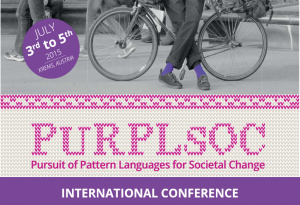
Von 3. bis 5. Juli 2015 fand an der Donau-Universität Krems nun nach dem PURPLSOC Preparatory Workshop im November 2014 die PURPLSOC 2015 (Pursuit of Pattern Languages for Societal Change) statt, die erste internationale Konferenz zum Thema Patterns (dt. Muster) und Pattern Languages (dt. Muster-Sprachen), die vom Department für Interaktive Medien und Bildungstechnologien in Kooperation mit dem Department für Bauen und Umwelt organisiert wurde. Die PURPLSOC findet abwechselnd mit dem PUARL (Portland Urban Architecture Research Laboratory) in Portland (USA) und jedes 2. Jahr in Krems statt. 2016 wird allerdings höchstwahrscheinlich San Francisco (USA) Austragungsort sein.
Christopher Alexander, Urheber der Mustertheorie, konnte aus gesundheitlichen Gründen leider nicht an der Konferenz teilnehmen und wandte sich deshalb mit folgender Grußbotschaft an alle Teilnehmerinnen und Teilnehmer:
Dear Conference Participants,
I wish you all the best for the First World Conference on Patterns and Pattern Languages. I am quite pleased that many people from different countries are gathering in my home country Austria. My family is actually from Vienna. I am also very pleased that you have assembled to continue the work I have started with my colleagues in Berkeley and elsewhere. Especially the fact that you are applying and researching this work in a number of disciplines is quite remarkable to me, and I wish you a great gathering and a positive outcome of your efforts.
With warm wishes,
Chris Alexander, Binsted, England, March 2015
Christian ASPALTER vom Didaktikzentrum für Text- und Informationskompetenz (DiZeTIK) und Reinhard BAUER vom Zentrum für Lerntechnologie und Innovation (ZLI) – auch ein Mitglied des PURPLSOC Programme Committee – waren mit einem gemeinsam erarbeiteten wissenschaftlichen Beitrag zum Thema Design, Rhetorik und Unterricht vertreten.
In ihrem Paper „From Noam Chomsky and Christopher Alexander to Heinrich Lausberg: Rhetorical Framing for Pattern Analysis“ gehen Aspalter und Bauer der Frage nach, wie die klassische Rhetorik mit ihren fünf partes artis (inventio, dispositio, elocutio, memoria und actio) sowie der intellectio zur Entwicklung eines Modells zur Beschreibung und Analyse von didaktischen Entwurfsmustern beitragen kann. Ihr Modell bezeichnen die beiden Forscher als Rhetorical Pattern Analysis (RPA).
Abstract zum Beitrag:
Within the educational context, pattern analysis is searching for universal patterns that provide solutions for educational problems as well as for universal assistance with learning and teaching in general. Insofar this approach can well be compared with the efforts in linguistics that, according to Chomsky, aim at making language accessible by linguistic universals (Bauer, 2013). This universalistic focus of pattern analysis also forms the basis of Christopher Alexander’s approach that attempts to derive linguistic universals in architecture from a highly stable basis (one may even be tempted to think of a pattern ontology) of natural phenomena (cf. Alexander, 1984, particularly pp. 14-16). This universalistic approach tends to lead to an excessive demand of didactic analysis because a stable universal grammar of an educational language is confronted with the variability of its application (pragmatics). In contrast to that, a linguistic analysis that is primarily oriented to the effect of its application can be found more likely in rhetoric (cf. Aristoteles, 1995). A first step in this direction is the rhetorical pattern analysis of film (cf. Joost, 2007). Here, the starting point of a formative language development and language application is always the concrete objective of a linguistic action. Here again we can search for a systematization, here again it is possible to make generalizations, and here again we focus on a system of linguistic effectiveness. And this systematization also claims to be a concept of complete order (Lausberg, 1990). However, rhetorical analysis always remains within the frame of a specific (spatial and temporal) relativity. However, the rhetorical system has the advantage that it starts from modifiable practice rather than from the hypothetical construct of stable preconditions.
Die Abstracts zu den Beiträgen aller anderen Konferenzteilnehmerinnen und Konferenzteilnehmer können im PURPLSOC 2015 Conference Booklet nachgelesen werden.
Im Rahmen der Konferenz wurde auch das Buch „PURPLSOC: The Workshop 2014“ mit zwei Beiträgen von Reinhard Bauer („E-Portfolio Design: Generic Rules for Creating Centers“ und „Planning Living Lessons: Christopher Alexander’s Structural Properties of Living Centers in an Educational Context“) präsentiert.
Eine der Besonderheiten der PURPLSOC 2015 war sicherlich auch die Mitwirkung von George PLATTS, Multimedia Artist und PLoP– bzw. EuroPLoP-Querdenker, der in den Game Sessions zwischen den einzelnen Vorträgen und Workshops die Teilnehmerinnen und Teilnehmer mit neuer Energie versorgte. 🙂
Literatur- und Linktipps:
- World Conference 2015: PURPLSOC – Pursuit of Pattern Languages for Societal Change, 3. bis 5. Juli 2015 an der Donau-Universität Krems
- Bauer, Reinhard (2014). Didaktische Entwurfsmuster: Diskursanalytische Annäherung an den Muster-Ansatz von Christopher Alexander und Implikationen für die Unterrichtsgestaltung. Dissertation. Alpen-Adria-Universität Klagenfurt. Online verfügbar unter http://ubdocs.uni-klu.ac.at/open/hssvoll/AC10776663.pdf. [Erscheint im Herbst 2015 in der Reihe „Internationale Hochschulschriften“ des Waxmann Verlags.]
- Bauer, R. (2013). Den Unterrichtenden eine Sprache geben: Was didaktische Entwurfsmuster für die Gestaltung von Unterricht leisten können – eine Überlegung. In G. Reinmann, M. Ebner & S. Schön (Hrsg.), Hochschuldidaktik im Zeichen von Heterogenität und Vielfalt. Doppelfestschrift für Peter Baumgartner und Rolf Schulmeister (S. 129-149). Norderstedt: Books on Demand.
- Bauer, Reinhard & Baumgartner, Peter (2011). Showcase of learning: towards a pattern language for working with electronic portfolios in higher education. In Proceedings of the 16th European Conference on Pattern Languages of Programs (EuroPLoP ’11). ACM, New York, NY, USA, Article 6, 30 pages. DOI=10.1145/2396716.2396722. http://doi.acm.org/10.1145/2396716.2396722.
- Bauer, Reinhard & Baumgartner, Peter (2011). A First Glimpse at the Whole: Christopher Alexander’s Fifteen Fundamental Properties of Living Centers and Their Implication for Education. In C. Kohls & J. Wedekind (Eds.), Investigations of E-Learning Patterns: Context Factors, Problems and Solutions (pp. 272-284). Hershey, New York: IGI Global.
- Bauer, Reinhard & Baumgartner, Peter (2010). The potential of Christopher Alexander’s theory and practice of wholeness: clues for developing an educational taxonomy. In: Proceedings of the 15th European Conference on Pattern Languages of Programs (EuroPLoP ’10). ACM, New York, NY, USA, Article 12, 21 pages. DOI=10.1145/2328909.2328924. http://doi.acm.org/10.1145/2328909.2328924.
- Bauer, Reinhard & Baumgartner, Peter (2012). Schaufenster des Lernens: Eine Sammlung von Mustern zur Arbeit mit E-Portfolios. Münster & New York: Waxmann.
Impressionen von der PURPLSOC 2015
- Opening PURPLSOC 2015

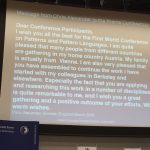
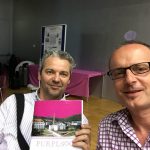
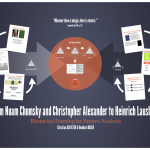
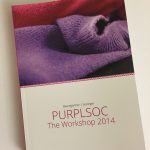
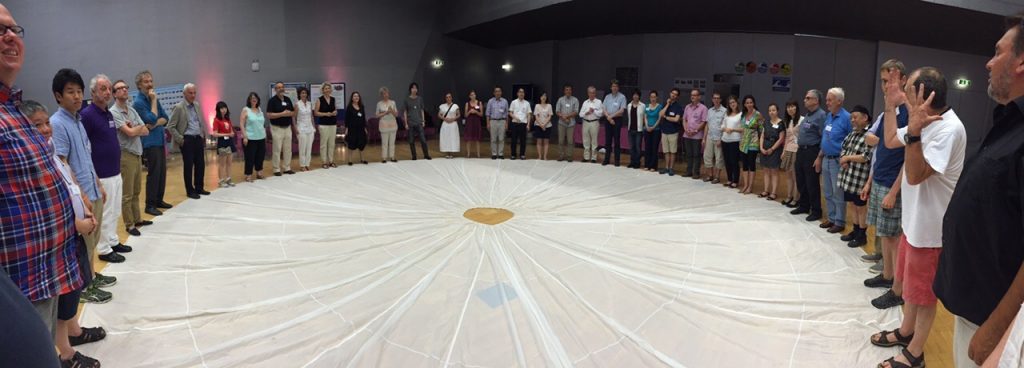
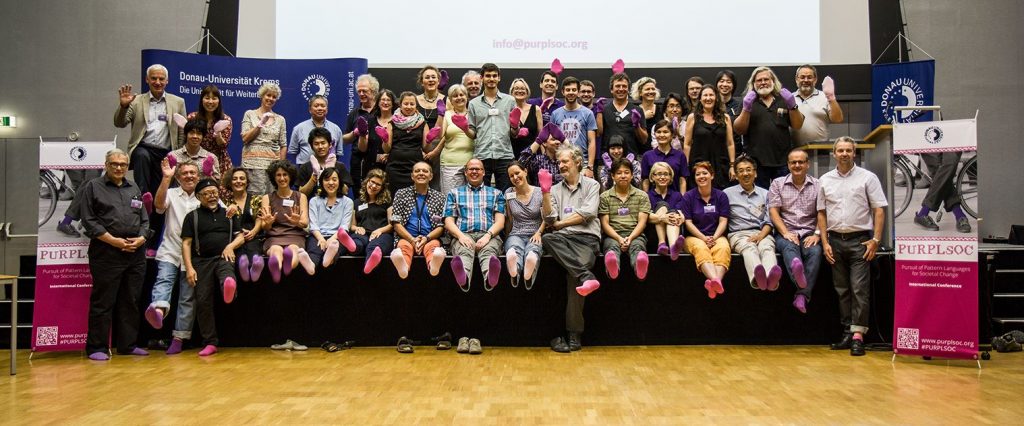
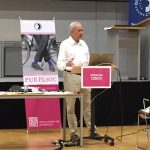

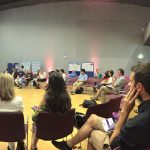
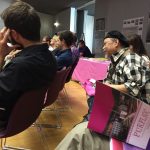
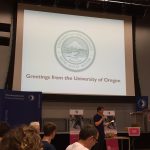
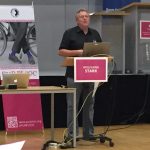
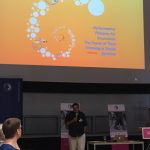
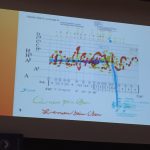
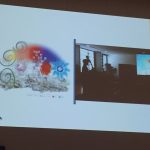

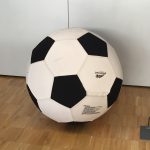
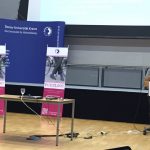
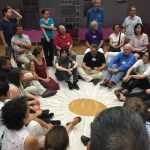
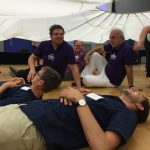


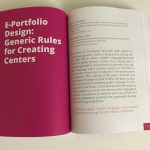
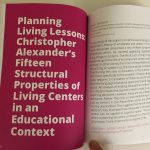
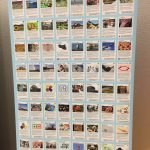
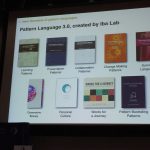
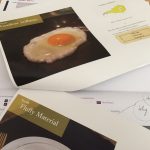
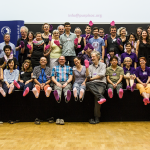
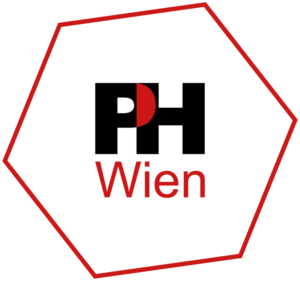
Schreibe einen Kommentar